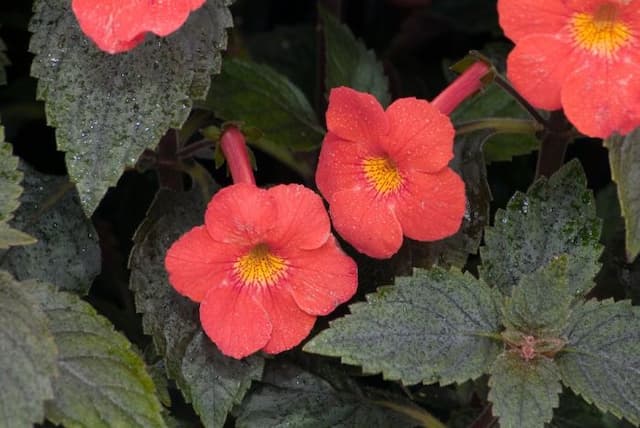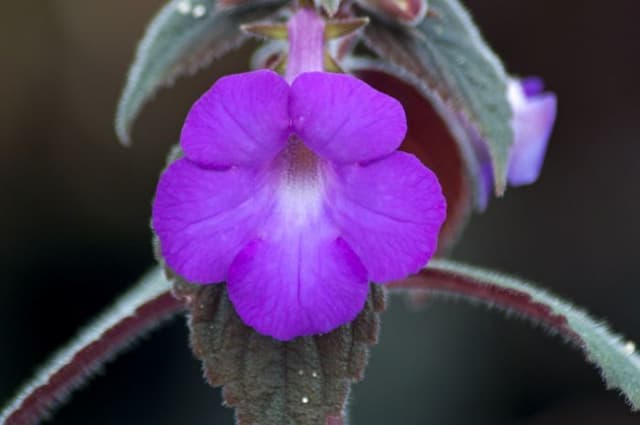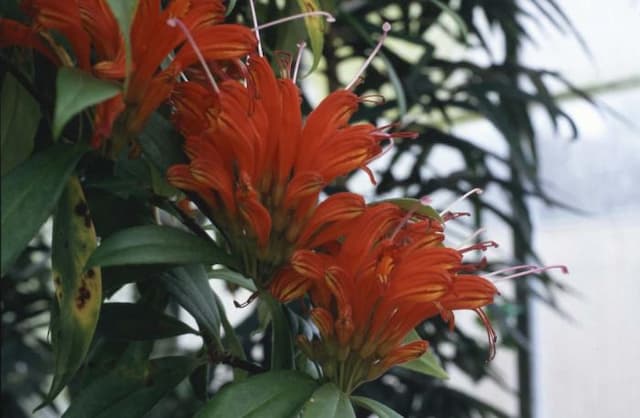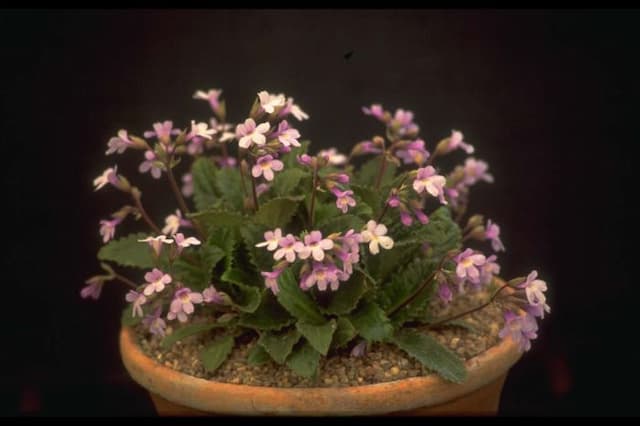Cape primrose 'Cariad' Streptocarpus 'Cariad'

ABOUT
'Cariad' is a tender, compact perennial with evergreen, strap-shaped foliage and clusters of tubular flowers borne over a long period from spring into autumn. Each flower has pink to purple upper lobes and lower lobes with darker pink to reddish colours streaked over a white background
About this plant
 Names
NamesFamily
Gesneriaceae
Synonyms
Cape Primrose, African Violet Cousin
Common names
Streptocarpus 'Cariad'.
 Characteristics
CharacteristicsLife cycle
Perennials
Foliage type
Evergreen
Color of leaves
Green
Flower color
Pink
Height
6 inches (15 cm)
Spread
18 inches (45 cm)
Plant type
Herb
Hardiness zones
10
Native area
Africa
Benefits
 General Benefits
General Benefits- Easy Maintenance: Streptocarpus 'Cariad' requires minimal care, making it ideal for busy plant owners or beginners.
- Long Blooming Period: It can bloom for several months with proper care, providing a long-lasting display of flowers.
- Attractive Foliage: The plant has lush, green leaves that add aesthetic value to any space.
- Compact Size: Its small stature makes it suitable for indoor spaces, including small apartments or offices.
- Colorful Varieties: Offers a range of colors and patterns in its flowers, allowing for personalization of decor.
- Non-Toxic: Safe for homes with pets and children, as it is not known to be toxic.
 Medical Properties
Medical PropertiesThis plant is not used for medical purposes.
 Air-purifying Qualities
Air-purifying QualitiesThis plant is not specifically known for air purifying qualities.
 Other Uses
Other Uses- Textile Dye: The vibrant leaves and flowers of the Cape primrose can be used to create natural dyes for fabric, offering a range of subtle to vivid colors depending on the mordant used.
- Art Supplies: The crushed petals of Cape primrose can be mixed with a binding agent to produce botanical paints for traditional painting techniques or children's crafts.
- Photography Backdrops: With their lush foliage and colorful blossoms, Cape primroses can serve as an attractive and natural backdrop for macro or product photography.
- Edible Garnishes: Though not widely known for culinary uses, the flowers of Cape primrose can be used as delicate edible garnishes for desserts and salads, provided they are free from pesticides.
- Botanical Illustration: Artists may find inspiration in the unique shapes and patterns of Cape primrose flowers and leaves, using them as subjects for botanical illustration studies.
- Pressing and Scrapbooking: The flowers and leaves of Cape primrose can be pressed and preserved for use in scrapbooking, card making, or other paper craft projects.
- Collection Hobby: Some enthusiasts enjoy collecting different varieties of Cape primrose, similar to how one might collect stamps or coins, for their diverse and vibrant appearances.
- Teaching Tool: Educators can use Cape primrose plants to teach students about botany, plant biology, and the care requirements of different types of houseplants.
- Scented Bouquets: While not traditionally known for their fragrance, some varieties of Cape primrose might lend a subtle scent to mixed flower arrangements.
- Mindfulness Practice: Tending to Cape primrose plants can be incorporated into mindfulness practice as a method for reducing stress and improving one's sense of well-being.
Interesting Facts
 Feng Shui
Feng ShuiThe Cape Primrose is not used in Feng Shui practice.
 Zodiac Sign Compitability
Zodiac Sign CompitabilityThe Cape Primrose is not used in astrology practice.
 Plant Symbolism
Plant Symbolism- Enduring Love: The name 'Cariad' is a Welsh word that translates to 'love' or 'beloved', signifying deep affection and lasting emotional bonds.
- Adaptability: Streptocarpus, also known as Cape Primrose, often symbolizes the ability to adapt to various conditions as they can thrive in varied environments.
- Resilience: Known for their capacity to bounce back after neglect, Cape Primrose can represent the strength and resilience to recover from challenges.
 Water
WaterCape Primrose should be watered regularly to keep the soil evenly moist but not soggy. Typically, watering once a week will suffice, but this depends on the humidity and temperature of your environment. During the growing season, offer about 8-16 ounces of water each time, depending on the size of your pot. It's crucial to use room temperature water and to water under the leaves to avoid spot formation. In the winter months, reduce watering to every other week, just enough to prevent the soil from drying out completely.
 Light
LightCape Primrose flourishes in bright, indirect light. It's ideal to place the plant near a north or east-facing window where it can receive plenty of light without being exposed to the harsh midday sun. Avoid direct sunlight, particularly in the summer months, to prevent leaf scorch.
 Temperature
TemperatureCape Primrose prefers temperatures between 60 and 75 degrees Fahrenheit. It should not be exposed to temperatures below 50 degrees Fahrenheit as it can cause damage to the plant. The ideal temperature range for promoting flowering and growth is maintaining a consistent room temperature around the low to mid 70s Fahrenheit.
 Pruning
PruningCape Primrose benefits from occasional pruning to encourage bushier growth and more blooms. Prune back leggy stems after flowering or whenever the plant appears overgrown, typically a couple of times a year. The best time for pruning is in the early spring or after a flowering cycle when the plant is starting to regrow.
 Cleaning
CleaningAs needed
 Soil
SoilThe Cape Primrose prefers a light, airy potting mix with good drainage, consisting of two parts peat moss or coco coir, one part perlite, and one part vermiculite or fine bark. The ideal soil pH for this plant should be slightly acidic to neutral, in the range of 6.0 to 7.0.
 Repotting
RepottingCape Primroses should be repotted about once a year, preferentially in the spring. If they are not outgrowing their pots, simply refreshing the top layer of soil can be sufficient for their health and growth.
 Humidity & Misting
Humidity & MistingCape Primroses thrive in moderate to high humidity levels, ideally between 50-60%. They benefit from a humid environment but do not like to be misted directly. Using a pebble tray with water or a humidifier can help achieve the desired humidity level.
 Suitable locations
Suitable locationsIndoor
Place in bright, indirect light; ensure constant mild humidity for the Cape Primrose.
Outdoor
Shelter from direct sun, keep in warm, shaded area with high ambient humidity for the Cape Primrose.
Hardiness zone
10-11 USDA
 Life cycle
Life cycleThe life cycle of Streptocarpus 'Cariad', commonly known as the Cape Primrose, begins with seed germination, where the tiny seeds need light to germinate and should be sown on the surface of a well-draining soil mix. After germination, the seedlings develop into young plants with a rosette of leaves; during this growth stage, the plant should be kept in bright but indirect light to avoid scorching the leaves. As the plant matures, it sends out long flowering stems with tubular flowers, which can be various shades of pink or purple, and this blooming stage can occur multiple times throughout the year with proper care. After flowering, if pollinated, the plant may produce seed capsules which, when mature, can burst open to distribute the seeds for reproduction. In their natural habitat, the cycle continues as these seeds germinate to produce new plants, but in cultivation, the plant is often propagated vegetatively from leaf cuttings, which involves cutting a healthy leaf into sections and planting them to grow new plants. Over its lifespan, which can be several years with proper care, Cape Primrose will periodically enter a rest period where growth slows down, requiring less watering before resuming active growth and flowering.
 Propogation
PropogationPropogation time
Spring-Early Summer
The Streptocarpus 'Cariad', commonly known as the Cape Primrose, is often propagated through leaf cuttings, a method that is most popular due to its simplicity and effectiveness. To propagate the Cape Primrose using leaf cuttings, a healthy and mature leaf is selected and then cut across the width, aiming for pieces about 2 to 3 inches (5 to 7.6 centimeters) long. Each piece is then inserted into a well-draining soil mix, ensuring that the cut edge is buried just below the surface. The soil should be kept moist but not waterlogged, and the cuttings should be placed in a warm area with indirect light. In a few weeks, new growth will emerge from the base of the leaf cuttings, indicating that roots have formed and a new plant is beginning to grow.









